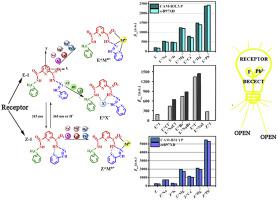Journal of Molecular Graphics and Modelling ( IF 2.9 ) Pub Date : 2020-07-08 , DOI: 10.1016/j.jmgm.2020.107652 Yao Yao 1 , Yuan Zhang 1 , Xiang Li 1 , Yong-Qing Qiu 1

|
A photoswitchable heteroditpioc ion-pair receptor E-1 and its isomeride Z-1 (without the anion binding site), that are based on the 2-pyridyl acylhydrazone linking 2,6-pyridine bisamide, have brought our attention to systematically explore the second-order nonlinear optical (NLO) properties by the density functional theory (DFT). In this work, we mainly studied the influences of metal cations (M = Na+, K+, Mg2+, Ca2+, Hg2+ and Pb2+), anions (X = Cl−, Br− and I−) and ion-pair (NaCl, NaBr and NaI) on NLO responses for the receptor. In addition, the impacts of isomerization and poto-switching processes on NLO response for these systems also have been discussed detailedly. The results show that the isomerization process does not effectively adjust the NLO properties for our studied systems. But the poto-switching process that was triggered by light to capure or release ions plays an important role in improving the NLO properties. The receptors E-1 and Z-1 are excellent candidates to effectively detect metal cation Pb2+, because the first hyperpolarizability (βtot) values of E∗Pb2+ and Z∗Pb2+ increased by 13 times and 20 times relative to that of receptors E-1 (188.06 a.u.) and Z-1 (270.21 a.u.), respectively. In addition, the receptor E-1 has the possibility to detect anion I− due to the larger βtot values compared with other anion-complexes. However, the changes of NLO responses for ion-pair complexes are not obvious compared with corresponding anion-complexes. We are looking forward to the research would be beneficial for further theoretical and experimental studies on recognizing metal cations and anions based on large second-order NLO difference.
中文翻译:

基于2-吡啶基酰基hydr与2,6-吡啶双酰胺连接的可光转换异二吡咯离子对受体的二级NLO性质:金属阳离子和阴离子的影响。
基于2-吡啶基酰基hydr连接2,6-吡啶双酰胺的光开关异二吡咯离子对受体E-1及其异构体Z-1(无阴离子结合位点)引起了我们的注意,系统地研究了第二种密度泛函理论(DFT)的高阶非线性光学(NLO)特性。在这项工作中,我们主要研究的金属阳离子(M =钠的影响+,K +,Mg的2+,钙2+,汞2+和Pb 2+),阴离子(X =氯- ,溴-和我-)和离子对(NaCl,NaBr和NaI)对受体的NLO反应。此外,还详细讨论了异构化和钾离子交换过程对这些系统的NLO反应的影响。结果表明,对于我们研究的系统,异构化过程不能有效地调节NLO性质。但是,由光触发的趋于稳定或释放离子的电位切换过程在改善NLO特性方面起着重要作用。受体E-1和Z-1是优良的候选有效地检测金属阳离子的Pb 2+,因为第一超极化率(β TOT)的值E *的Pb 2+和Z *的Pb 2+相对于受体E-1(188.06 au)和Z-1(270.21 au)分别增加了13倍和20倍。此外,该受体E-1具有检测阴离子我的可能性-由于较大的β TOT值与其它阴离子配合物相比较。但是,与相应的阴离子配合物相比,离子对配合物的NLO反应变化并不明显。我们期待该研究将对基于大二阶NLO差异识别金属阳离子和阴离子的进一步理论和实验研究有所帮助。



























 京公网安备 11010802027423号
京公网安备 11010802027423号